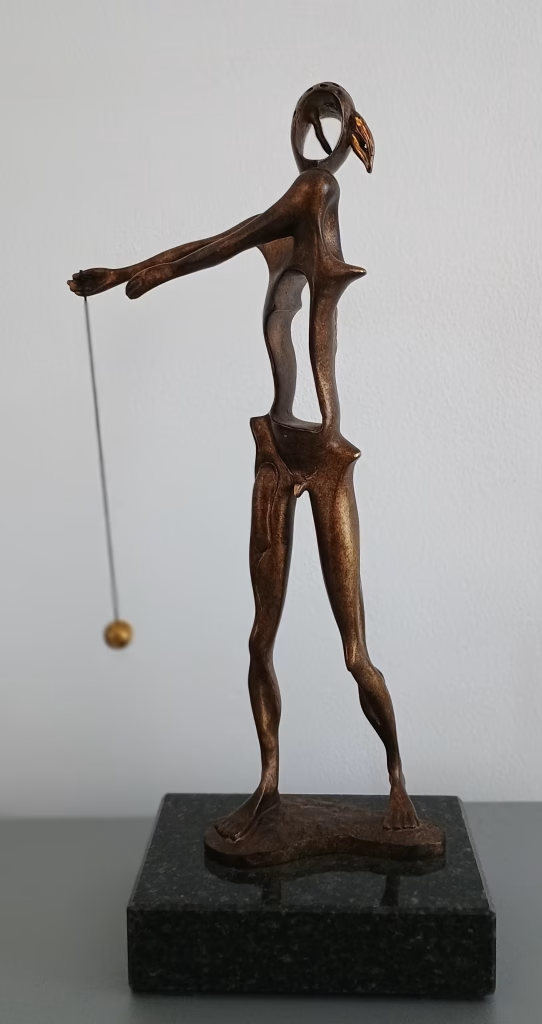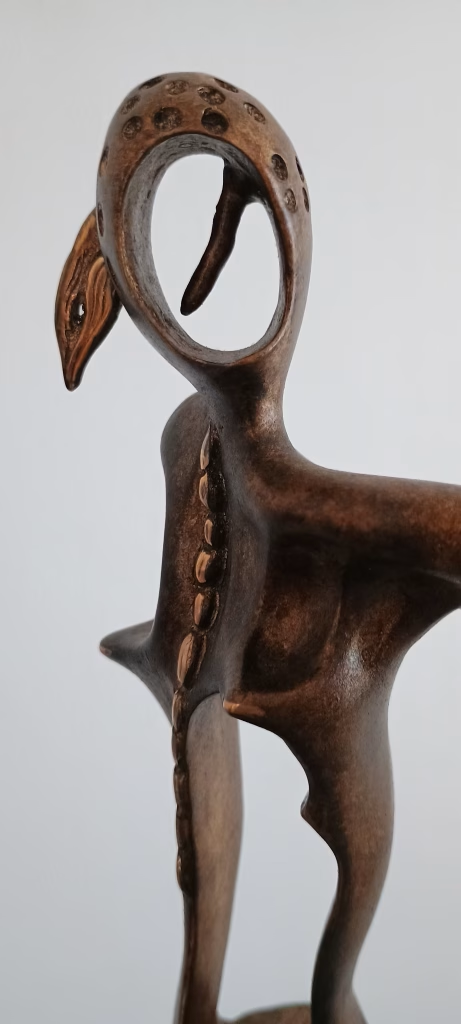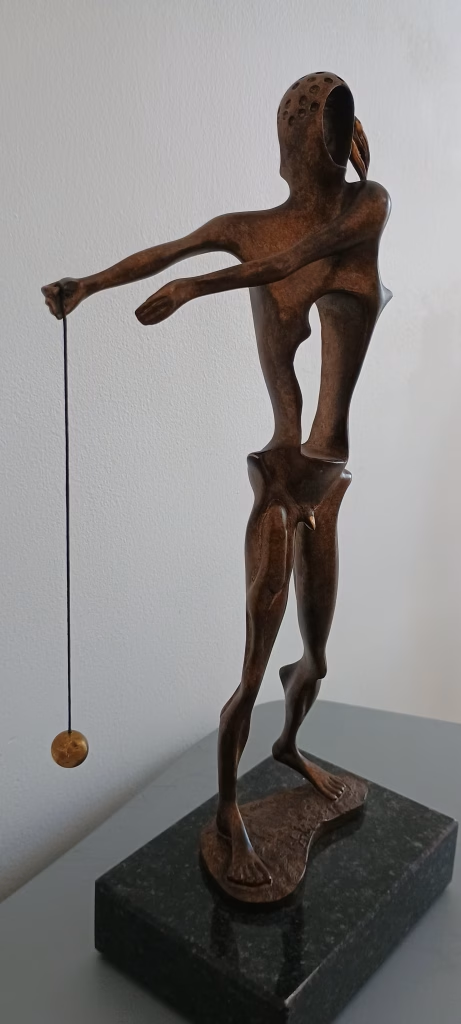Homage to Newton: A Surrealistic Exploration of Science, Genius, and the Human Condition
Salvador Dalí’s Homage to Newton is a powerful bronze sculpture that encapsulates the artist’s lifelong fascination with the intersection of art, science, and the subconscious. Conceived in 1980, this work is not a mere portrait of Sir Isaac Newton but a profound surrealist tribute that delves into the nature of genius, the sacrifice of personal identity for the sake of discovery, the universal laws that govern the physical and metaphysical worlds and the mechanisms of collective memory. The sculpture’s striking and fragmented form, a disfigured human figure with two prominent holes, in the torso and in the head, serves as a visual manifesto for Dalí’s philosophical and artistic beliefs during his “nuclear mysticism” period.

The Context of Dalí’s Scientific Obsession
To fully appreciate Homage to Newton, one must understand Dalí’s deep and enduring relationship with science and mathematics. Throughout his career, Dalí was captivated by the scientific and technological advancements of the 20th century. He saw a profound connection between the mysteries of the atomic world and the inner workings of the human psyche, and he sought to merge these seemingly disparate realms in his art. His interest was not merely casual; he studied physics and mathematics extensively, following the new theories and discoveries and maintaining friendships with notable figures in science, like Matila Ghyka and René Thom.
The mid-20th century marked a shift in Dalí’s work, a period he called “Nuclear Mysticism.” Impressed and inspired by the advancements in nuclear physics that brought to the atomic bombing of Hiroshima and Nagasaki, he began to incorporate elements or interpretations of atomic particles, DNA strands, and divine geometry into his art. He believed that the discoveries of quantum mechanics and nuclear physics offered a new, deep understanding of reality that transcended the psychological realm. In his 1958 Anti-Matter Manifesto, he even declared that his new “father” was the physicist Werner Heisenberg, displacing Sigmund Freud as his primary intellectual influence. This era of Dalí’s career focused on depicting the universe not as a collection of solid objects but as a swirling vortex of energy and non-touching particles. This philosophical underpinning is crucial to the interpretation of Homage to Newton, as on one side this sculpture is the fruit of his fascination for the scientific discoveries and on the other the emphasis on void as part of matter at the atomic level explains the ethereal, almost floating quality of the sculpture’s elements and its use of negative space.
Newton in Dalí´s artistic work
The figure in Homage to Newton is a variant of a figure that first appeared in the background Dalí’s 1932 painting, Phosfène de Laporte. This link demonstrates how Dalí often revisited and transformed his own motifs, translating a two-dimensional figure from a painting into a three-dimensional sculpture. By bringing this figure into a new medium, he was able to explore its themes of scientific discovery and human form in a more tangible, volumetric way. Throughout his artistic life he revised this image in a few different version, sometimes representing Newton without his arms, sometimes adding a sphere hanging inside the torso and another time with some softer traits like the long hair and a more classical body shape of the Surrealist Newton.
The Anatomy of Genius: A Symbolic Deconstruction

The most striking features of the sculpture are its two large holes, one in the head and another in the torso. These voids are not mere design elements; they are the heart of the sculpture’s symbolic meaning. Dalí uses them to illustrate a concept central to his tribute: the idea that a living being can be so consumed by an intellectual pursuit that their physical identity and vital organs are stripped away, leaving only the pure, hard essence of their discovery.
The hole in the head can also be interpreted as a powerful symbol of “open-mindedness”. Dalí suggests that to make a world-changing discovery, one must be willing to empty their mind of conventional thought and embrace radical new ideas. The hole in the torso, located where the heart would be, could symbolize “open-heartedness,” a quality Dalí saw as essential for any significant human endeavor, including scientific exploration. Together, these voids present a vision of a genius who has given his entire being—his physical body, heart, and mind—to the pursuit of knowledge.
What remains of the body is excavated, the vertebrae visible and polished, the hips and the scapulae protruding … the body is purified from muscles, flesh and fat, only the essential is still visible.
The reduction of Newton´s body to a mere silhouette is also emphasizing the memory we have of historical figures, that are remember only for their achievements, while we ignore and forget their physical aspect, their feelings and all the thoughts not bound to their discovery. They are remembered not as human beings but as an extension of their findings and their role in the human and scientific evolution. Sir Isaac Newton, as a person, has been reduced to a timeless, impersonal name in the annals of science.
The Apple of Gravity: From Soft to Hard
The sculpture directly references the famous anecdote of Newton’s discovery of gravity, which was supposedly sparked by a falling apple. In Dalí’s interpretation, the apple is represented not as a soft, delicate fruit, but as a rigid, metallic sphere. This transformation from a perishable object to an immutable, solid form signifies the nature of Newton’s discovery—the “hard” law of gravity. One sphere hangs from a thin line from the figure’s hand, representing the precise, unwavering trajectory of a falling object. In the monumental version of this sculpture, another sphere is suspended within the figure’s abdominal area, further abstracting the concept of the “apple” while simultaneously serving as a substitute for the figure’s heart, reinforcing the idea of a sacrifice of personal identity for the sake of scientific law.
The Sculpture
Homage to Newton was conceived in 1980 and first cast in the same year. The sculpture is made of bronze, cast at the Perseo Art Foundry following the lost wax process and features a brown patina. A black granite base completes the composition. The sculpture has been exhibited worldwide and is a well-known part of the Dalí Universe collection.
Perhaps the most notable version of the sculpture is the large-scale monument that stands in a plaza in Madrid, Spain. At almost five meters high, this monumental version of Homage to Newton commands a powerful public presence, elevating the tribute to Newton and Dalí’s own legacy to a grand scale. The existence of a public, monumental version emphasizes the importance Dalí placed on this piece and its message about the universal significance of scientific inquiry.

The Homage to Newton
Homage to Newton is a masterpiece of surrealist sculpture that goes beyond a simple commemorative image. Through its fragmented form, it explores the relationship between the human body and the intellect, portraying Sir Isaac Newton not as a human and historical figure but as an embodiment of the transformative power of discovery. By linking a famous scientific anecdote with his own artistic language of dreams, voids, and contrasts, Dalí creates a timeless piece that pays tribute to the genius who discovered gravity and, at the same time, questions the nature of individuality in the face of universal truths. The sculpture stands as a testament to Dalí’s belief that art and science are not separate entities, but intertwined paths toward a deeper understanding of the world.

What are your thoughts on this unique sculpture? Do you want to see or purchase it? contact us and wel´ll be happy to direct you to the nearest gallery that exhibits one!
